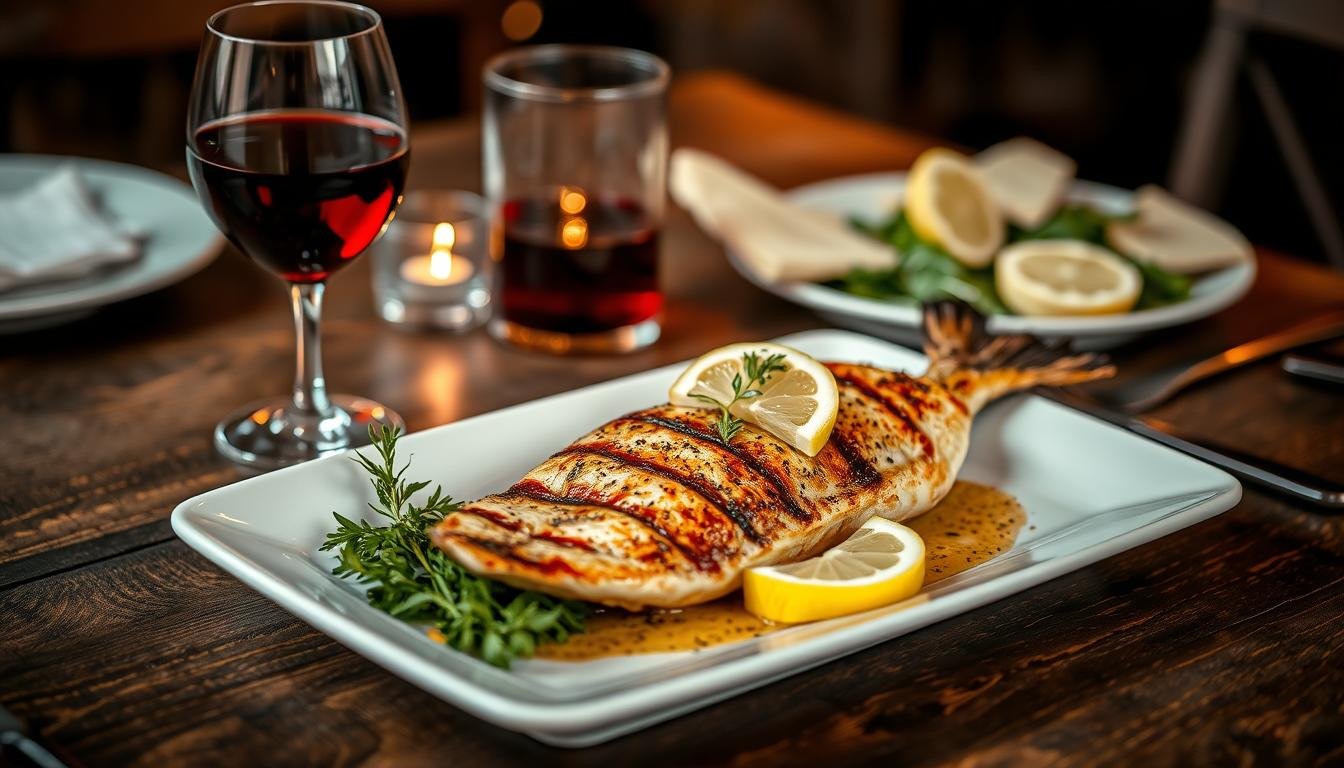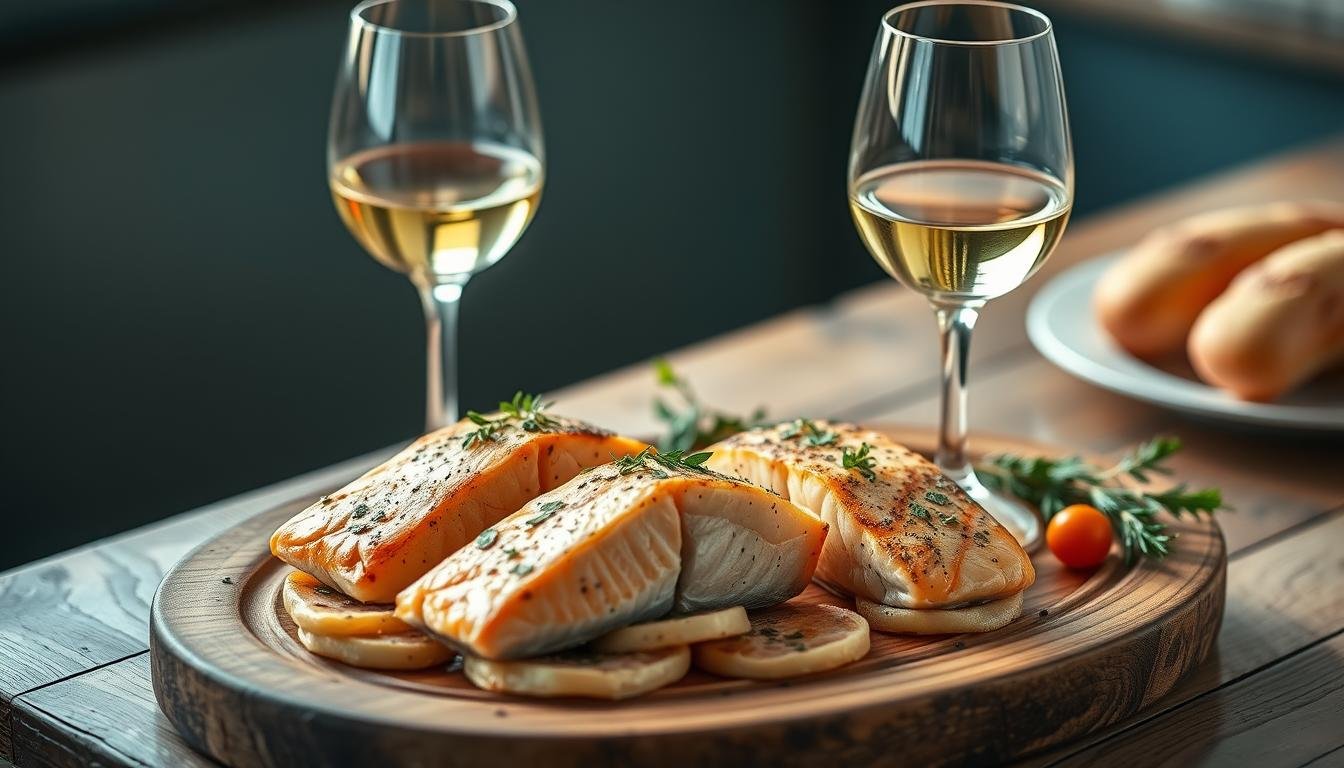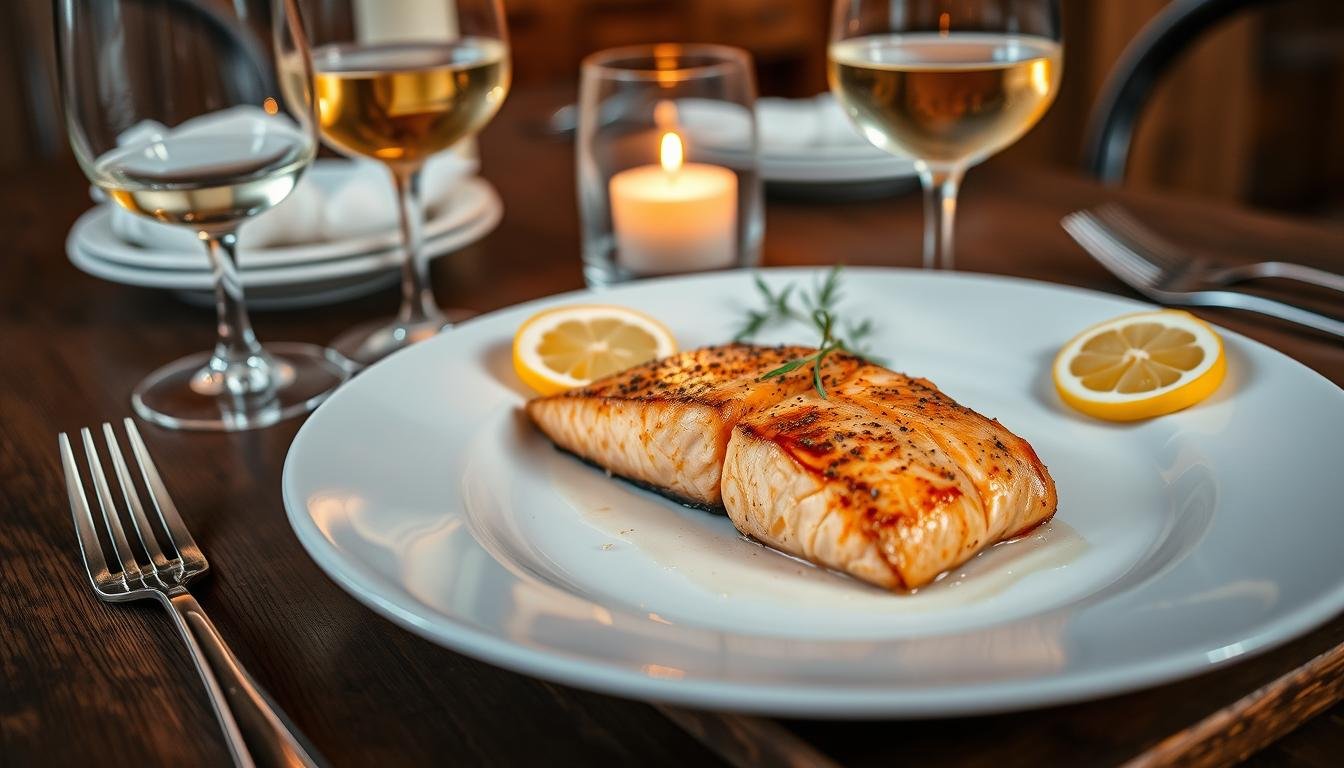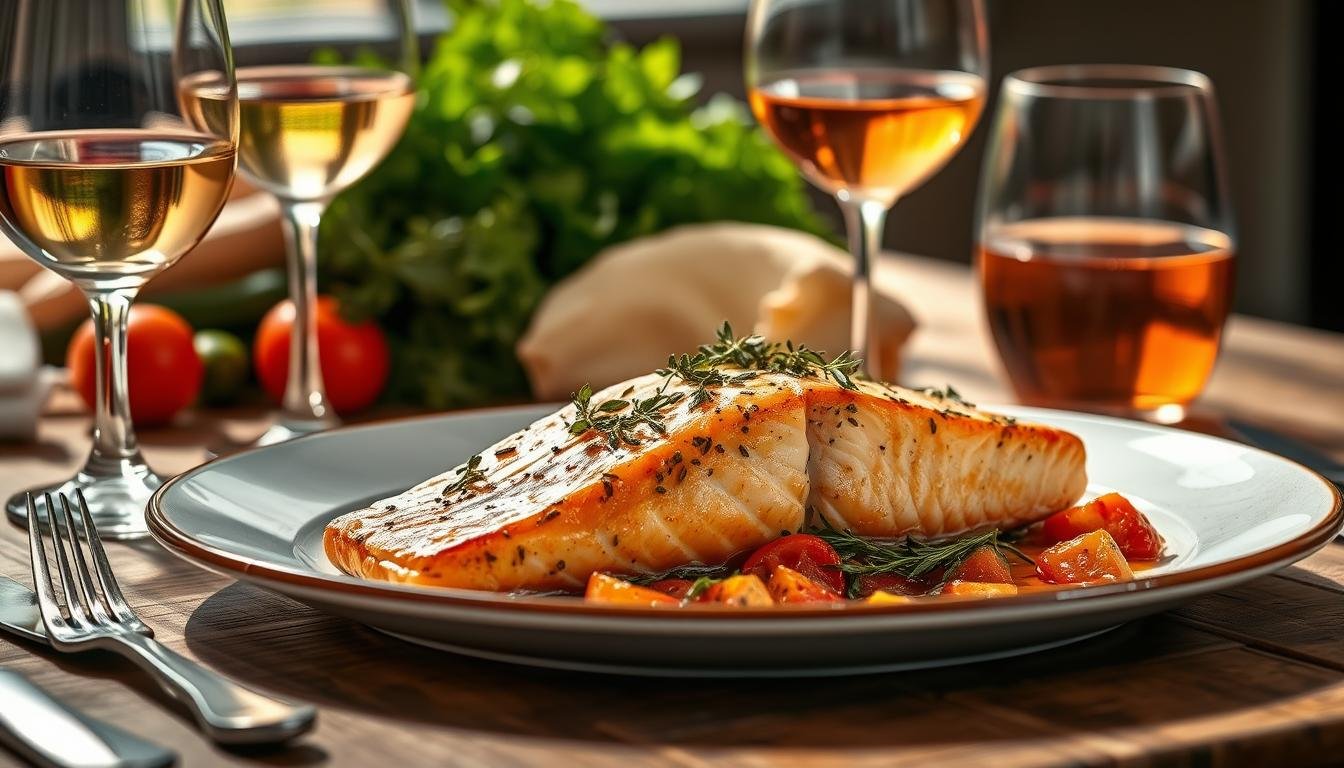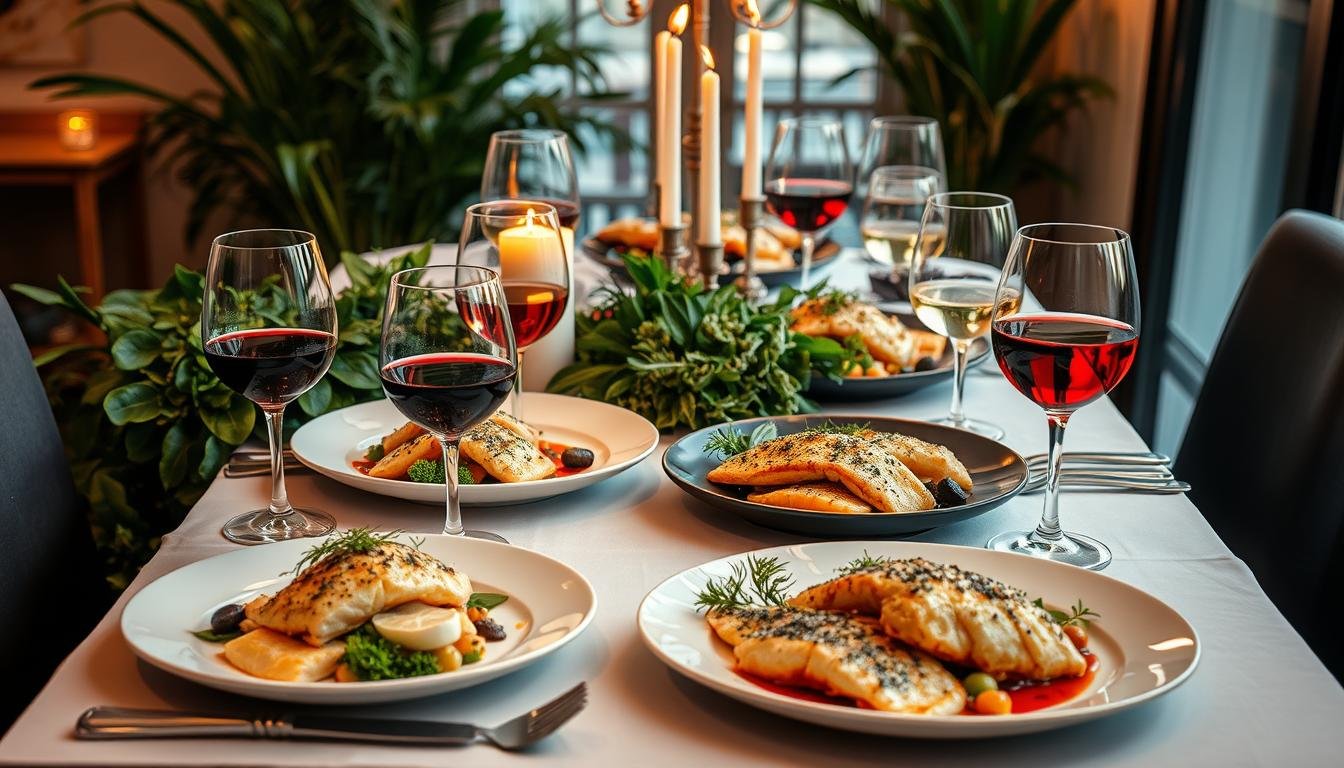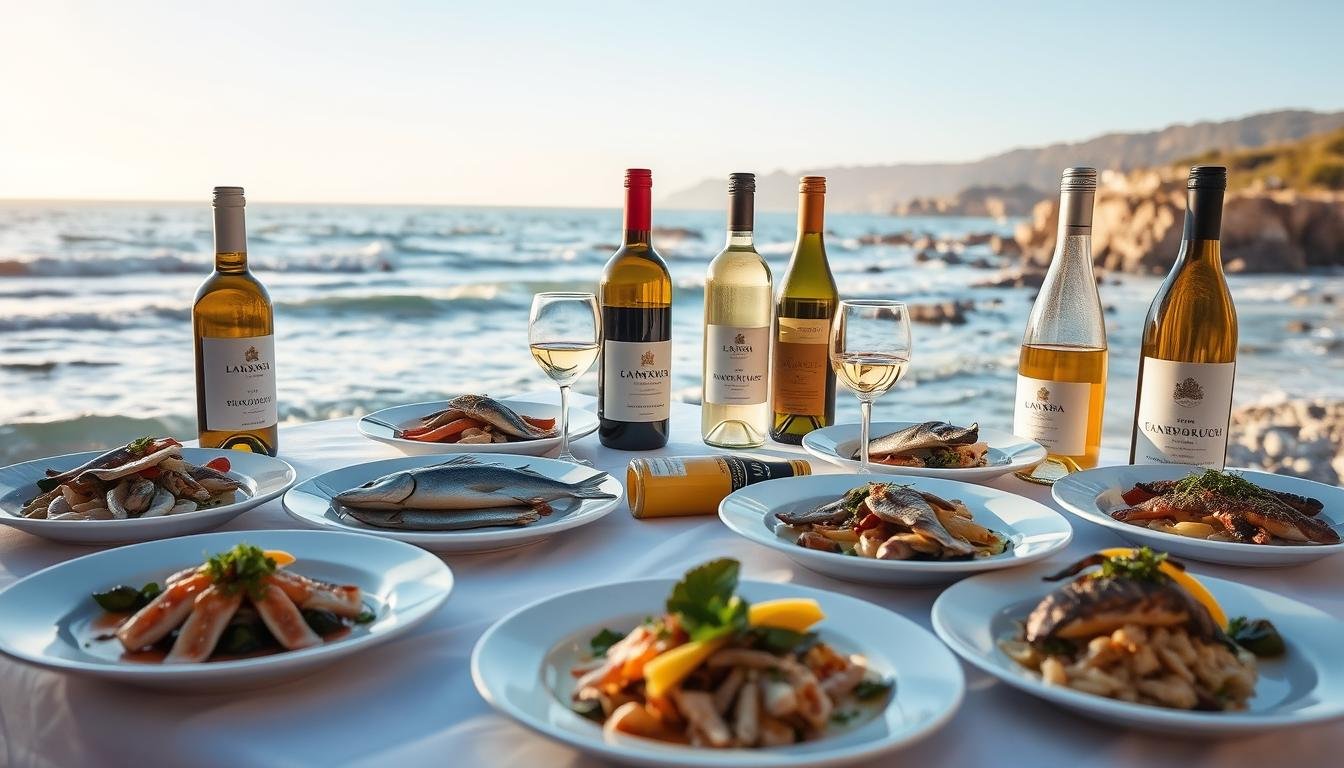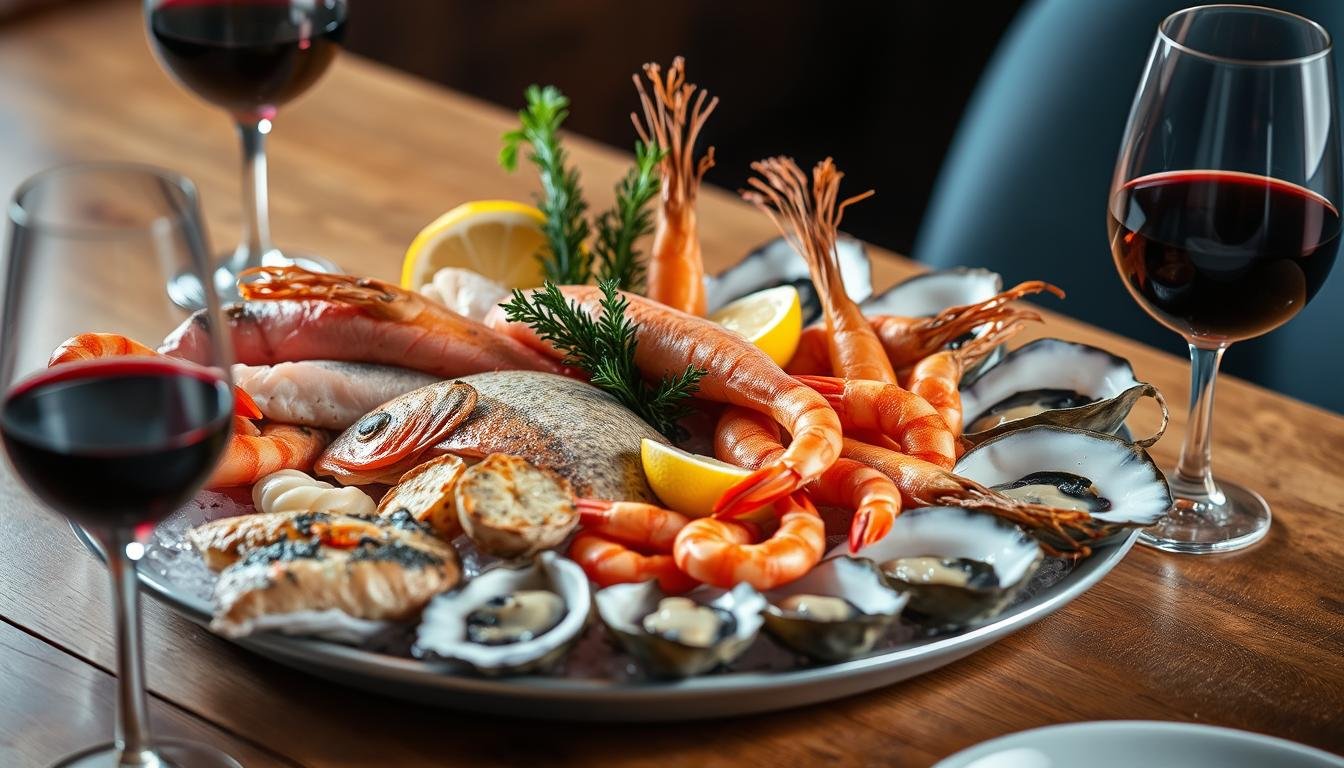Many think red wine and fish don’t go together. But, the right red wine can make fish dishes taste amazing. Whether it’s a light white fish or a fatty fish, the right wine can highlight its flavors. Knowing how to match red wine with fish is key to a great meal.
Finding the perfect red wine for fish is more complex than white wine. This guide will teach you about wine and food pairings. You’ll learn about red wine types and how they match with fish flavors. Plus, discover how cooking methods and sauces can change the pairing. Start your journey to a better seafood pairing and enjoy a memorable meal.
Key Takeaways
- Red wine can complement fish, enhancing the dining experience.
- Matching wine acidity with food richness creates balance.
- Light-bodied red wines like Pinot Noir pair well with delicate fish.
- Preparation methods influence the best wine choice.
- Understand complementary vs. contrasting flavors for optimal pairings.
Understanding the Basics of Wine Pairing
To make your meals better, learning about wine pairing is key. It’s an art and science that can make food taste even better. Let’s explore why it’s important and how acidity and tannins in wine help.
Why Pair Wine with Food?
Pairing wine with food is more than tradition. It’s about finding a balance that makes meals better. Sommeliers use their knowledge to suggest perfect pairings for dishes. They focus on matching flavors or contrasting them to add depth.
For example, a spicy dish paired with sweet wine can be more enjoyable. It brings out unique flavors and makes the taste experience better.
The Role of Acidity in Wine
Wine acidity is key for balancing rich or fatty foods, especially with fish. Wines like Sauvignon Blanc or Vinho Verde work well with fatty fish. They refresh your palate between bites.
Also, wines with high acidity pair well with bright sauces like lemon or tomato. This makes the meal more cohesive and fun.
Tannins and Fish: The Myths Explained
Many think tannins in wine don’t go with fish. But, it’s not always true. Lighter reds like Pinot Noir or Gamay can go well with richer fish like tuna or swordfish. Knowing how tannins work helps pick the right reds to complement the dish.
Learning these basics can improve your dining experiences. Whether at a fancy restaurant or at home, you’ll enjoy your meals more.
Common Types of Red Wine
Knowing the different red wines is key to perfecting wine pairing, especially with fish. By sorting red wines into light, medium, and full-bodied, you can find the ideal wine for your meal.
Light-Bodied Red Wines
Light-bodied wines have soft and subtle tastes. They include Pinot Noir and Gamay, which are less tannic and more acidic. This makes them great with lighter fish dishes.
Pinot Noir, for example, pairs well with smoked sablefish. It balances the fish’s buttery taste without being too strong.
Pinot Noir is also good for grilled fish. Its boldness complements the smokiness of the dish. Choose light-bodied wines for poached or steamed fish to keep flavors delicate.
Medium-Bodied Red Wines
Medium-bodied wines are a middle ground, pairing well with various fish. Merlot and Zinfandel work well with dishes that have more flavor. Salmon, with its bold taste, pairs well with these wines.
Tuna’s steak-like texture also goes well with medium-bodied reds. This creates a perfect mix of flavors.
Full-Bodied Red Wines
Full-bodied wines are rich and have more alcohol. Syrah and Shiraz are good for rich fish. Sablefish, with its high oil content, needs a wine that can match its boldness.
Salmon, known for its versatility, can also pair with fuller reds. This is especially true when grilled or roasted.
Here’s a table to help you pair these wines with fish:
| Type of Fish | Best Pairing Red Wine | Characteristics |
|---|---|---|
| Smoked Sablefish | Pinot Noir | Light-bodied, earthy undertones |
| Salmon | Merlot | Medium-bodied, versatile |
| Tuna | Zinfandel | Medium-bodied, robust |
| Grilled Fish | Pinot Noir | Light-bodied, slightly bold |
| Roasted Fish | Syrah | Full-bodied, rich |
Fish Varieties and Their Flavor Profiles
Knowing about fish flavors is key to finding the perfect wine match. It makes your meals better. Different fish, from soft white fish to oily ones, need different wines. Let’s look at some fish types to help you choose.
White Fish: Cod, Sole, and Haddock
White fish like cod, sole, and haddock taste mild and are flaky. They have subtle flavors, perfect for light wines. Wines like Pinot Grigio and Albariño work well because they’re zesty and citrusy.
For white fish with butter or cream sauces, try an unoaked Chardonnay. It keeps the flavors fresh and lively.
Oily Fish: Salmon, Mackerel, and Tuna
Oily fish like salmon, mackerel, and tuna have rich, fatty textures and bold tastes. They’re great with red wine, especially ones with soft tannins. A light Pinot Noir is good for grilled fish.
An oaked Chardonnay or Viognier works well with creamy sauces. For tips on pairing with salmon, check out this expert guide on pairing salmon.
Shellfish: Shrimp, Lobster, and Clams
Shellfish like shrimp, lobster, and clams offer unique pairing chances. Their salty taste goes well with wines that show mineral notes. Muscadet or Chablis are great for this.
For dishes with herbs or citrus, Sauvignon Blanc’s crispness is perfect. If you’re using creamy sauces, oaked Chardonnay or Viognier adds richness without hiding the shellfish’s taste.
By learning about fish flavors, you can try new wine and fish pairings. It will make your cooking adventures more exciting.
Classic Food and Wine Pairing Principles
Learning about food and wine pairing can make your meals better. It’s about matching flavors and textures to enjoy your food and wine more.
Complementary vs. Contrasting Flavors
Pairing food and wine can be about matching or contrasting flavors. For example, a tomato pasta dish goes well with Sangiovese wine because they both have high acidity.
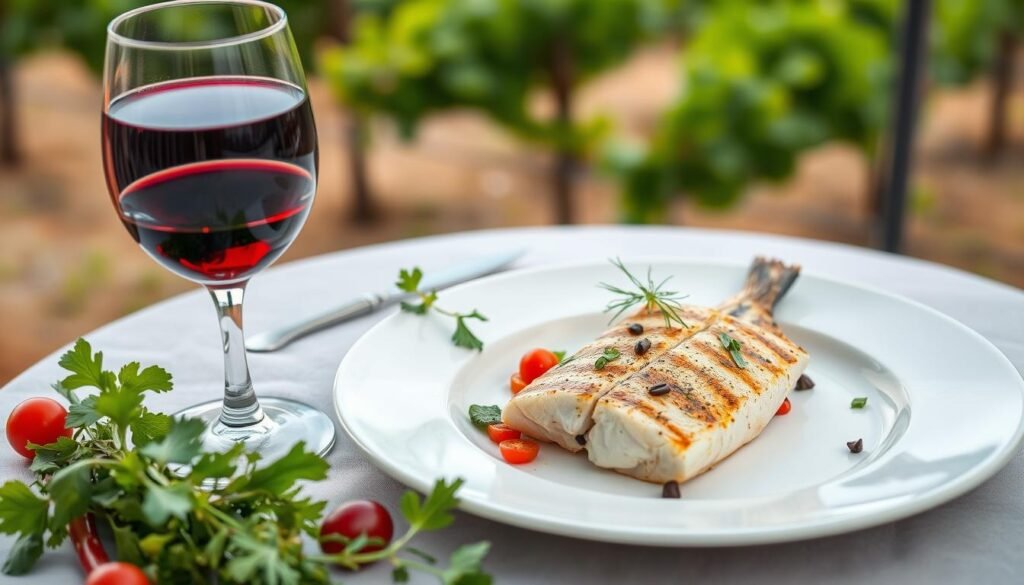
On the other hand, a rich wine like Cabernet Sauvignon pairs well with fatty steak. The wine’s tannins help soften the steak’s fat. Check out classic pairing examples to learn more.
The Importance of Texture and Body
The texture and body of food and wine matter a lot. A bold red wine, like Syrah, goes great with hearty dishes like roasted lamb.
Lighter fish, like salmon, pairs well with wines with moderate tannins, like Pinot Noir.
Seasonal Pairing Techniques
Seasonal pairings make the most of food and wine flavors. In summer, try Rosé with grilled tuna for a light, refreshing taste.
In winter, richer wines like Bordeaux pair well with roasted meats for a cozy feel. Learn about seasonal wine pairing techniques to enhance your meals all year.
Pairing Red Wines with Light Fish
When pairing red wines with light fish, certain choices stand out. Cod, sole, and flounder have delicate flavors and textures. Pinot Noir and Gamay are great options to enhance both the wine and fish.
Pinot Noir: A Gentle Choice
Pinot Noir is a perfect match for light fish. It has subtle tannins and balanced acidity. Master Sommelier George Miliotes says it’s versatile for many fish dishes, like grilled sole.
The wine’s gentle berry notes and silky texture complement the fish. Try pairing it with grilled or pan-seared cod for a delightful experience. This balance ensures the fish’s delicacy is enhanced.
Gamay: Fruity and Vibrant
Gamay is known for its vibrant and fruity profile. Carlin Karr notes its low tannin levels and high acidity make it great for lighter fish. It’s perfect for fish that might be overpowered by tannic wines.
Gamay’s fruity nature brings out the brightness in dishes like pan-seared sole. A Gamay from Beaujolais Cru adds refreshing red berry flavors. This wine’s lively character complements simple fish preparations.
Try pairing pan-seared cod with a fruity Gamay for a balanced and flavorful experience. This combination is a great way to experiment with light fish pairings.
| Light Fish | Recommended Wine | Pairing Notes |
|---|---|---|
| Grilled Sole | Pinot Noir | Enhances the delicate flavor, complements the texture |
| Pan-Seared Cod | Gamay | Fruity and vibrant, adds brightness to the dish |
Follow these expert recommendations for harmonious pairings. For more insights, check out this resource here.
Pairing Red Wines with Rich Fish
Pairing red wines with rich fish dishes is all about matching bold flavors. This section looks at Syrah and Zinfandel. These wines are great with intense fish like salmon or tuna.
Syrah/Shiraz: Bold and Flavorful
Syrah is known for its strong and complex taste. It’s perfect for rich fish like black cod, also known as sablefish. The fish’s velvety texture and high oil content match Syrah’s boldness.
Smoked sablefish paired with Syrah is a great match. The wine’s earthy notes complement the fish’s buttery taste. Syrah also brings out the bold flavor in tuna steak, making for a memorable meal.
Zinfandel: Unconventional yet Delicious
Zinfandel is grown mainly in California’s Napa and Sonoma Valleys. It has high acidity and moderate tannins. This makes it a great match for grilled or pan-seared salmon.
The wine’s fruity and vibrant taste enhances salmon’s rich fat content. Zinfandel’s versatility also makes it a good choice for rich fish dishes. It challenges the idea that only white wine pairs well with fish.
For more on wine pairing, check out here and here. These resources offer tips to improve your wine pairing skills.
Here’s a table to help you understand these pairings better:
| Fish Type | Wine Pairing | Characteristics |
|---|---|---|
| Sablefish | Syrah | Rich, velvety texture |
| Salmon | Zinfandel | High acidity, moderate tannins |
| Tuna | Syrah | Bold, complex flavors |
The Role of Preparation in Pairing
When pairing red wine with fish, how the fish is prepared matters a lot. Different cooking methods change the fish’s flavor, affecting the best wine match. Let’s look at how grilling versus roasting changes things, and how the impact of sauces and seasonings affects the dish.
Grilled vs. Roasted Fish Dishes
Grilling fish adds a smoky flavor that boosts its natural taste. This cooking method goes well with wines that have earthy or bold notes. For instance, a Pinot Noir or an oaked Chardonnay pairs well with grilled salmon or tuna.
Roasting fish makes it taste richer and more intense. This method needs wines that can handle the stronger flavors. Light red wines like Pinot Noir or fuller-bodied whites like Chardonnay or Chenin Blanc are great for roasted fish.
Sauces and Seasonings: An Influential Factor
The impact of sauces and seasonings on fish is huge. They can change the dish’s flavor and feel. For example, creamy sauces need wines like Assyrtiko or crisp Muscadet to balance them. Spicy seasonings call for wines with a bit of sweetness, like Riesling or Gewürztraminer.
Umami-rich sauces, like soy or teriyaki, need wines that can match their strong flavors. A light red like Gamay or a rosé works well. Knowing how these elements work with fish preparation helps pick a wine that complements, not overpowers, your dish.
| Cooking Method | Wine Pairing | Suggested Fish |
|---|---|---|
| Grilling | Pinot Noir, Oaked Chardonnay | Salmon, Tuna |
| Roasting | Chardonnay, Chenin Blanc | Halibut, Cod |
| Frying | Bone-dry sparkling wine | Sablefish, Catfish |
| Poaching/Steaming | Sauvignon Blanc, Pinot Grigio | Sole, Flounder |
Regional Pairing Suggestions
Exploring regional pairings can make your meals more enjoyable, especially with seafood. Whether you like Old World wines or New World wines, there’s a perfect match for every seafood dish.
Old World vs. New World Wines
Old World wines come from traditional European places. They have subtle flavors and a strong sense of place. For example, a crisp Muscadet or Chablis pairs well with delicate shellfish like oysters and clams.
New World wines, from places like the United States, Australia, and New Zealand, have bold and fruity tastes. A New Zealand Sauvignon Blanc can make white fish like sole or sea bass taste even better. It adds vibrant acidity and fresh citrus notes.
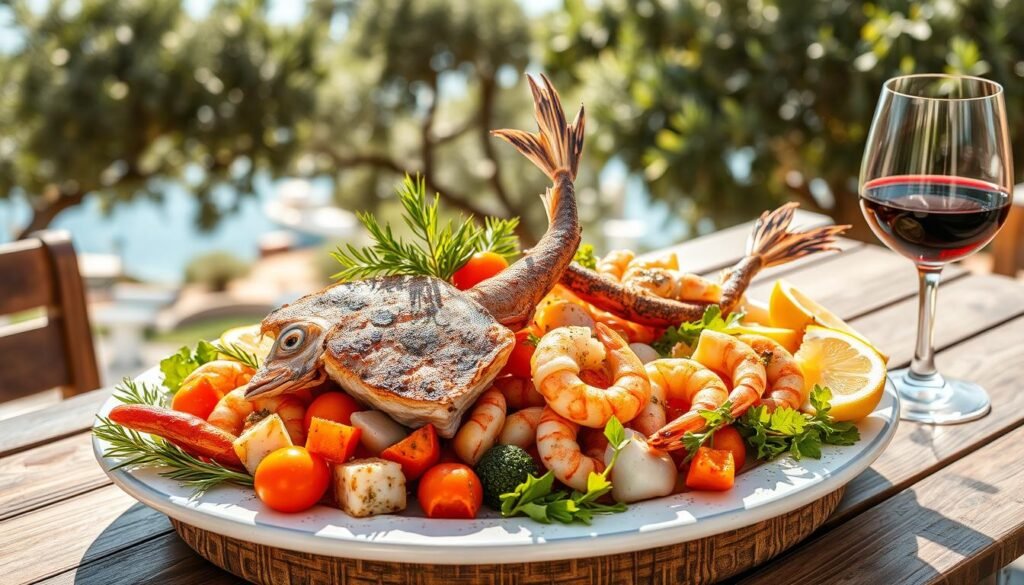
Notable Pairings from Mediterranean Cuisine
The Mediterranean is known for its tasty seafood dishes. These dishes pair well with both Old World and New World wines. For a classic pairing, try grilled sardines with a chilled Pinot Noir from California. The wine’s light tannins and fruity taste balance the sardines’ strong flavor.
Tomato-based sauces like puttanesca are also key in wine pairing. They enhance the taste of tuna, making it great with a Grenache from Spain. Creamy sauces with Mediterranean lobster pair well with an oaked Chardonnay from France.
You can find more pairing techniques and suggestions by visiting this comprehensive guide on Caymus wine.
| Types of Fish | Old World Wine Pairing | New World Wine Pairing |
|---|---|---|
| Light and Flaky Fish (e.g., Sole, Sea Bass) | Pinot Grigio, Albariño | Sauvignon Blanc |
| Medium-textured Fish (e.g., Snapper, Trout) | Unoaked Chardonnay, Dry rosé | Oaked Chardonnay |
| Rich Fish (e.g., Salmon, Tuna) | Oaked Chardonnay, Viognier | Pinot Noir |
| Fish with Strong Flavors (e.g., Sardines, Anchovies) | Gewürztraminer, Grüner Veltliner | Chilled Pinot Noir |
| Shellfish (e.g., Shrimp, Lobster) | Muscadet, Chablis | Sauvignon Blanc |
Experimenting with Unconventional Pairings
Exploring new wine pairings can be exciting and creative. It breaks away from old rules and lets you enjoy wine with fish in your own way. Try experimental pairings to see what you like best.
Your Own Flavor Explorations
Start by knowing the flavors and textures of your fish and wine. For instance, sablefish (black cod) is oily and buttery. It goes well with oaky or creamy Chardonnay. A zesty Sauvignon Blanc also works well, bringing out the fish’s sweetness.
For smoked sablefish, a light red Pinot Noir adds earthy notes that match the fish nicely.
Salmon pairs well with Pinot Noir, especially when grilled or roasted. A creamy Chardonnay is great with salmon in creamy sauces. A fruity Rosé is perfect for smoked salmon. Paying attention to these details can make your wine pairings even better.
Seeking Personal Preferences
Don’t be afraid to try different wines to find what you like. For example, roasted halibut’s buttery notes are enhanced by oaked Chardonnay. A dry Riesling balances the sweetness of the fish.
Tuna’s meaty texture is great with smooth Merlot, especially for grilled or seared dishes. A Syrah is perfect for spice-rubbed or blackened tuna.
“Preparation methods and accompanying flavors often outweigh the type of fish being served,” noted Katharina Gnigler, renowned sommelier at Bootshaus. She highlights the role of culinary creativity in wine pairings.
Remember, trying new wine pairings is all about finding new favorites. Try a light red with seafood dishes usually paired with whites. Look for new wine varieties like Muscaris and Souvignier gris. Your personal taste in wine will guide you to a fun and open-minded dining experience.
Tips for Serving Wine with Fish
Understanding how to serve wine with fish can really enhance your dining experience. It’s all about choosing the right glassware and the perfect serving temperature. These wine serving tips will take your meals to a whole new level.
Serving Temperature: Importance and Recommendations
The proper serving temperature is key to pairing wine with fish. Red wines should be lightly chilled, between 15-20°C. This temperature helps keep the wine’s delicate balance and brings out the fish’s flavor.
For example, white wines like Chardonnay and Riesling do well at 8-12°C. This cooler temperature lets their crisp acidity and flavors complement fish dishes like grilled halibut or roasted salmon.
Wine with fishpairing is an art. The wine’s temperature can make or break the experience. For dishes like ceviche and tartares, the right temperature brings out their fresh acidity.
Glassware: Choosing the Right Wine Glass
Selecting wine glassware is crucial. The glass’s shape affects the wine’s aroma and taste. For reds like Merlot or Pinot Noir, a broad bowl glass is best. It lets the wine breathe and its aromas to flourish.
On the other hand, white wines like Sauvignon Blanc or Chenin Blanc need narrower glasses. These glasses highlight their crisp acidity. Having the right glassware for each wine type ensures the best tasting experience.
Here’s a comparison table to help you choose the right glassware for different wines:
| Wine Type | Best Glass Shape | Ideal Serving Temperature (°C) |
|---|---|---|
| Pinot Noir | Broad Bowl | 15-20 |
| Chardonnay | Narrower Bowl | 8-12 |
| Riesling | Narrower Bowl | 8-12 |
| Merlot | Broad Bowl | 15-20 |
By following these tips and choosing the right glassware, you can create a memorable dining experience. It will perfectly complement the flavors of your fish dish.
Common Mistakes in Pairing Red Wine with Fish
Pairing red wine with fish can be tricky. Knowing what to avoid makes a big difference. Here, we’ll cover common mistakes and how to avoid them.
Overly Complex Flavors in Pairings
Trying too hard with flavor pairings is a big mistake. Wines like Cabernet Sauvignon or Syrah can overpower fish. These wines clash with fish’s delicate taste, ruining the meal.
Go for lighter wines like Pinot Noir or Gamay instead. They add flavor without overwhelming the fish. Also, watch the alcohol level. Wines with more than 12% alcohol can make dishes taste spicier, which isn’t always good. For more tips, check out this guide on red wine and fish
Ignoring Personal Taste Preferences
Not listening to your own taste is another mistake. Everyone’s taste is different. What you like matters most when enjoying a meal.
If you love a certain red wine with your favorite fish, go for it. It’s about enjoying your meal, not following rules. Experts say trying new things can lead to great discoveries in food and wine.
| Type of Mistake | Example | Recommended Alternative |
|---|---|---|
| Overly Complex Flavors | Pairing fish with Cabernet Sauvignon | Pair with Pinot Noir |
| High Alcohol Content | Using wines over 12% with spicy fish dishes | Wines under 12%, such as Beaujolais |
| Ignoring Personal Preferences | Selecting wines based on rigid rules | Exploring and enjoying personal favorites |
Avoiding these mistakes and focusing on what you like can make meals better. Don’t be afraid to try new things and find what you enjoy most.
Conclusion: Enjoying Your Wine and Fish Pairing
As we wrap up our guide on pairing red wine with fish, remember a few key points. Confidence in your choices is key. Learning the basics and trying new things will make your meals better.
Confidence in Your Pairing Choices
While it’s true that light wines go well with light fish and bold wines with hearty seafood, trust your taste. For example, 90% of sommeliers say light wines are best for light fish. But, a bold choice might just wow you. Remember, there’s no one right way to pair wine and food. Trust your gut and use guides like Wine Kalli to try new things.
Embracing Culinary Creativity
Pairing wine and fish is a creative journey. Don’t stick to the usual. Try different wines, cooking methods, and flavors. For instance, 80% of experts say acidity boosts seafood flavors. But, a light red like Pinot Noir can make a big impact on a grilled salmon or seared tuna.
Think about adding sparkling wines or light ales to your pairings, especially with fried or rich seafood. It’s all about enjoying what you like. With these tips and your creativity, you’re ready to master wine and fish pairings. Enjoy the journey and keep exploring the world of wine and food pairings. Cheers to your future adventures!

